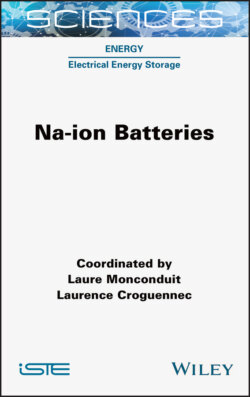Читать книгу Na-ion Batteries - Laure Monconduit - Страница 35
1.4. P2-type layered materials 1.4.1. Practical issues of P2-type materials for Na-ion batteries
ОглавлениеSimilar to the O3-type layered sodium 3d transition metal oxides (including O’3-type ones), P2-type sodium 3d transition metal oxides have been developed for achieving high-capacity, high-power, long-life and safe Na-ion batteries: (1) increase in a reversible capacity and operation voltage, (2) suppression of significant interslab shrinkage and irreversible phase transitions, (3) smoothing voltage profiles with suppressed Na+/vacancy ordering, (4) suppressing insertion of water molecules to interslab spacing and (5) surface protection against moist air and HF attack. However, there is a significant difference between P2- and O3-type layered oxides with single 3d transition metal systems. In contrast to O3-type layered oxides in which most of 3d transition metals are able to be accommodated in the slab, P2 type phases crystallize with only V, Mn and Co as single 3d transition metal systems. P2-type materials are generally Na deficient and crystallize in the Na content of 0.5 ≤ x ≤ 0.8 in NaxMO2. Many researchers synthesize P2-type materials in the typical composition of Na2/3MO2 (Na2/3M3+2/3M4+1/3O2). The average valence of transition metals in Na2/3MO2 is +3.33 and tetravalent or higher valent transition metals are contained in the slab of a P2-type structure. Thus, P2-type materials are also able to contain various 3d and 4d transition metals, alkali metals and alkaline earth metals in the binary, ternary and quaternary systems. Furthermore, the influence of the different oxygen stacking of O3 and P2 types on the charge–discharge voltage is very small, as shown in Figure 1.13 (Kubota et al. 2018a), except for the high Na content region of 0.0 ≤ x ≤ 1/3 in Na1-xMO2. Thus, the strategy and knowledge of the multiple transition metal systems with inert-metal doping or surface coating, which are developed in O3-type materials, can be applied to P2-type materials and also from P2- to O3-type materials. Because of the specific oxygen stacking of the P2-type materials and unstable occupation of transition metal ions at the octahedral interslab sites, migration of transition metal ions is suppressed even in the high voltage region above 4 V. Thus, P2-type materials are usually charged to >4.0 V in order to increase the working voltage.
Figure 1.13. Charge/discharge curves of P2, P’3 and O3 type NaxCoO2 in Na cells. Reprinted with permission from Kubota et al. (2018a). Copyright 2018, Wiley-VCH. For a color version of this figure, see www.iste.co.uk/monconduit/batteries.zip
It should be noted that P2-Na2/3MnO2+y (Na4/(6+3y)Mn2/(2+y)O2, 0.05 ≤ y ≤ 0.25) has higher oxidation state of Mn than that of P’2-Na2/3MnO2 and Mn defects in the slab without lattice distortion (Stoyanova et al. 2010; Kumakura et al. 2016), which significantly influences the electrode performances. Our group recently reported that P2-Na0.59Mn0.90O2 having Mn defects in the slab without lattice distortion shows smooth charge/discharge voltage profiles and delivers an initial discharge capacity of 198 mAh g−1 in the range of 1.5–4.4 V. However, the capacity apparently decays during cycles, which is probably influenced by the Mn defects. On the other hand, P’2-Na0.64MnO2 (Na0.64Mn3+0.63Mn4+0.37O2) has lattice distortion caused by a higher content of Jahn–Teller active Mn3+ in the structure with the Mn-defect-free slab unlike P2-Na0.59Mn0.90O2. P’2-Na0.64MnO2 shows stepwise voltage profiles and delivers discharge capacity of 216 mAh g−1 in the range of 1.5–4.4 V. The stepwise voltage behaviors are mainly derived from Na+/vacancy ordering related with Jahn–Teller distortion (Kumakura et al. 2016). Jahn–Teller distortion is regarded as a detrimental factor to the battery performances of Li- and Na-ion batteries due to local strains and irreversible structural changes during charge/discharge and Jahn–Teller active Mn3+ is often avoided (Clement et al. 2016). However, P’2-Na0.64MnO2 having lattice distortion at initial state exhibits superior capacity retention and highly reversible phase transitions, which is quite interesting for upsetting conventional chemistry in the battery field. Li et al. (2016) also recently proposed beneficial assist of Jahn–Teller active Fe4+ ion enhancing Na diffusion at the end of charge, leading to further Na extraction. These inexpensive transition metals of Mn and Fe are available as a redox center in layered oxides for Na-ion batteries unlike Li-ion. Further new chemistry different from Li-ion is expected to appear in Na-ion chemistry.
